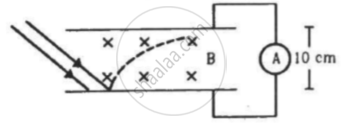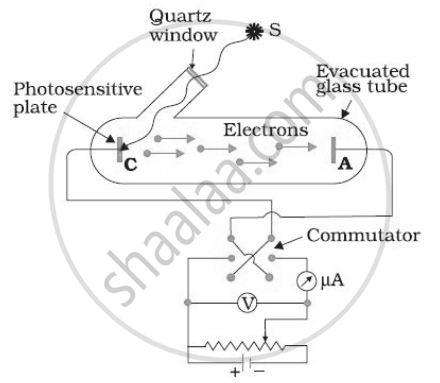Advertisements
Advertisements
प्रश्न
The stopping potential in an experiment on photoelectric effect is 1.5V. What is the maximum kinetic energy of the photoelectrons emitted? Calculate in Joules.
उत्तर १
We know that KEmax = eV0
V0 = 1.5V
= 1.6 × 10-19 × 1.5
= 2.4 × 10-19 J
KE = 2.4 × 10-19 J
उत्तर २
Using Einstein's photoelectric equation,
`("K.E".)_"max" = "hv" - phi = "h"("v" - "v"_@)`
⇒ `("K.E".)_"max" = "h"("v" - "v"_@) = "eV"_@`
Where Vo is the stopping potential.
According to the given data, Vo = 1.5 V
Hence,
`(K.E.)_"max" = "eV"_@ = "e" xx 1.5 "V" = 1.6 xx 10^-19 xx 1.5 "Joules")`
(K.E.)max = 2.4 × 10-19 Joules
संबंधित प्रश्न
Define the term "cut off frequency" in photoelectric emission. The threshod frequency of a metal is f. When the light of frequency 2f is incident on the metal plate, the maximum velocity of photo-electrons is v1. When the frequency of the incident radiation is increased to 5f, the maximum velocity of phto-electrons is v2. Find the ratio v1 : v2.
A photographic film is coated with a silver bromide layer. When light falls on this film, silver bromide molecules dissociate and the film records the light there. A minimum of 0.6 eV is needed to dissociate a silver bromide molecule. Find the maximum wavelength of light that can be recorded by the film.
(Use h = 6.63 × 10-34J-s = 4.14 × 10-15 eV-s, c = 3 × 108 m/s and me = 9.1 × 10-31kg)
In an experiment on photoelectric effect, light of wavelength 400 nm is incident on a cesium plate at the rate of 5.0 W. The potential of the collector plate is made sufficiently positive with respect to the emitter, so that the current reaches its saturation value. Assuming that on average, one out of every 106 photons is able to eject a photoelectron, find the photocurrent in the circuit.
In an experiment on photoelectric effect, the emitter and the collector plates are placed at a separation of 10 cm and are connected through an ammeter without any cell. A magnetic field B exists parallel to the plates. The work function of the emitter is 2.39 eV and the light incident on it has wavelengths between 400 nm and 600 nm. Find the minimum value of B for which the current registered by the ammeter is zero. Neglect any effect of space charge.

For a given frequency of light and a positive plate potential in the set up below, If the intensity of light is increased then ______.

In various experiments on photo electricity, the stopping potential for a given frequency of the incident radiation is ______.
When a beam of 10.6 eV photons of intensity 2.0 W/m2 falls on a platinum surface of area 1.0 × 10-4 m2, only 53% of the incident photons eject photoelectrons. The number of photoelectrons emitted per second is ______.
Cathode rays can be deflected by
In photoelectric effect, the photoelectric current
An increase in the intensity of the radiation causing photo-electric emission from a surface does not affect the maximum K.E. of the photoelectrons. Explain.
